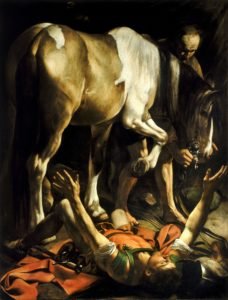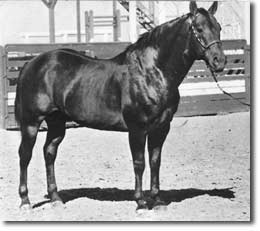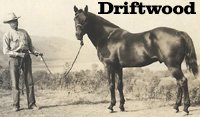
Michelangelo Merisi da Caravaggio is known as one of the greatest painters of his time. Critic Miles Unger says it best when he states that Caravaggio is best known for his “dramatic use of chiaroscuro to tell a story, his eye for the telling detail, and above all his ability to convey a familiar religious scene in vivid human terms”[1]. While Caravaggio is most often known for his more controversial works, it is his Conversion of Saint Paul on the Road to Damascus that truly stands out and demonstrates the full range of Caravaggio’s talents when addressing the subtleties of story-telling through his eye for detail.

The Conversion of Saint Paul came early in Caravaggio’s experimentation with chiaroscuro and tenebrism and is one of the few paintings to use an animal subject, particularly a horse, in such a manner. As critic and curator Meeka Walsh says: “it could be said-each of his paintings [are] a self-portrait”[2]. This is especially true of his Conversion of Saint Paul . The viewer’s perspective is set level with the centerline of the horse’s body, positioning Saul on his back in the foreground below the viewer with harsh light shining from the right of the picture plane, highlighting his prone body and shocked expression. Saul is on the ground in a vulnerable position beneath the horse. The horse itself is clearly representative of high society around Caravaggio.
The horse portrayed is a Spanish Jennet, a breed that was highly prized as a riding and carriage horse and all the rage during Caravaggio’s lifetime. The ornate bit in the horse’s mouth and the heavy shoes speaks to the horse’s status as a highly trained and prized animal. The horse poses so that if he were to put his foot down he would crush Saul’s leg, the heavy shoe on his hoof only adding to the level of damage that would be inflicted.
The Conversion of Saint Paul was painted at the beginning of Caravaggio’s fall from grace, reflecting his already disenfranchised view of the world around him. As Walsh said: “He was painting what he was seeing as he was living it. For his fellow night [travelers] and the people who lived provisionally on the street, the inhabitants of the underworld, chiaroscuro — the play of light and shadow — was not a painterly device but instead a necessary condition for survival”[2]. The Conversion of Saint Paul speaks to Caravaggio’s own experience with his fall from grace so soon after being drawn into the spotlight. However, there is a deeper cultural commentary that some might not see.
Caravaggio’s choices of color and light are never random or coincidental. This rule holds true here as well with the color he chose for the horse. According to the clear dorsal stripe showing down the horse’s hindquarters, the horse is a dun. Dun, as a primitive color, often expresses barring on the legs and withers. In Caravaggio’s Conversion of Saint Paul, he is careful to cover the legs and withers with pinto markings, preventing the primitive markings from being expressed. The white in the coat pattern symbolizes domestication as the ancestors of the Spanish Jennet would not have expressed a large amount of white in their natural habitat out on the steppe. Such a coat pattern in the wild would quickly be culled as it would make the animal more visible to predators. Caravaggio masterfully leaves just enough of the dorsal stripe on the hindquarters and a shadow of barring on the left front and back right legs visible to hint at the wildness that has been tamed by the white of domestication. This, combined with the uneven development of over exaggerated muscling on the legs juxtaposed with a layer of fat over the flanks and shoulders, is a clear commentary on the domestication, so to speak, of the art world as he saw it at the time and his view that none of them had enough vision to break from the accepted norm as these two traits cannot, to this degree, be found on the same horse at the same time.
The horse so poised above Saul might be taken as threatening, but the softness in his gaze and the tilt of his ears so masterfully and accurately captured portrays a level of concern for his rider that suggests the animal has no wish to harm the prone man. The head being lowered below the withers in such a manner portrays relaxation, lacking the tension that would accompany fear or aggression. And yet, as the horse seems concerned for his fallen rider, his gaze seems to fall upon the viewer, drawing the viewer into the painting as Caravaggio is wont to do.
According to scholar Giovanna Dell’Orto, Caravaggio’s innovative tenebrism came from his belief in “reality as it appears in a fraction of light and disappears in an eternity of shadow”[3]. This fascination with life and death and acute awareness of the inevitability of death is shown ever acutely in the Conversion of Saint Paul. It is a work that comes early enough in Caravaggio’s career to maintain his control and eye for meticulous detail, yet late enough to incorporate his unique usage of tenebrism as he portrays his subjects as actors on a stage highlighted in a spotlight for the world to see. The scene is both a deeply religious and universal experience while also being a heartbreakingly personal self-portrait of Caravaggio’s own fall from grace, darkly foreshadowing his own tragic end.
Caravaggio’s Conversion of Saint Paul on the Road to Damascus is often overshadowed by many of Caravaggio’s more controversial works, but the Conversion of Saint Paul holds much symbolism that goes unappreciated by many viewers without equestrian knowledge.
[1] Miles Unger, “Saints and Sinners: Caravaggio and the Baroque Image at the Mcmullen Museum of Art, Boston College,” Art New England 20 (1999) 35.
[2] Meeka Walsh, “Caravaggio: The Desired Body Flares Like an Apparition,” Border Crossings 29 (2010) 13.
[3] Giovanna Dell’Orto, “Caravaggio: Self-Portraits as Exploration of Living Reality,” Gazette Des Beaux Arts 138 (2001): 227.
(This article is adapted from a scholarly paper written for one of my college art history courses. It is not directly connected to stock horses, but it is a rare look at an accurate portrayal of a horse in classical art and a discussion of the subtleties that have been lost over time as few critics today have a working knowledge of horses.)







